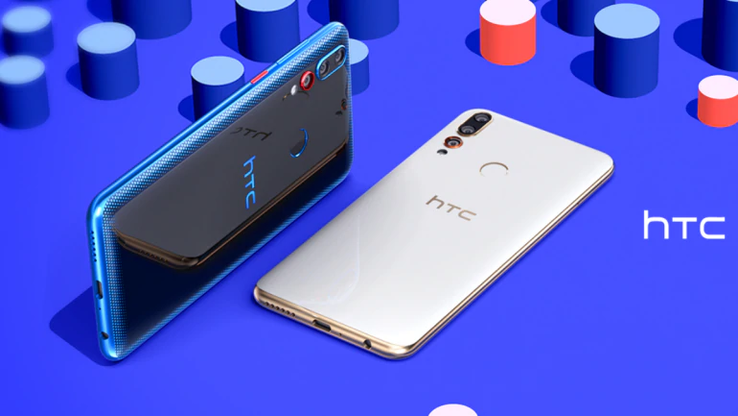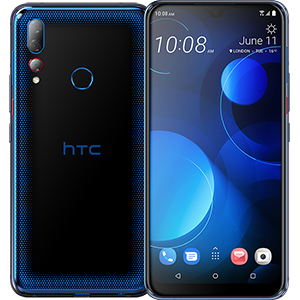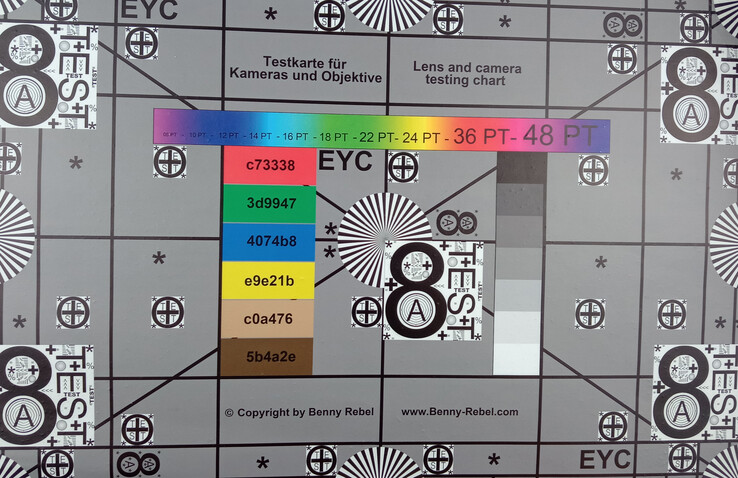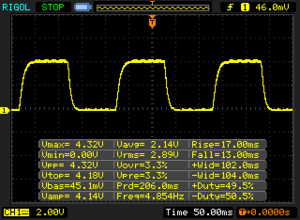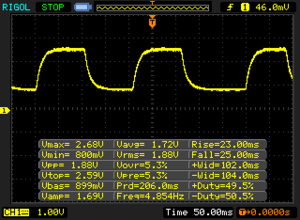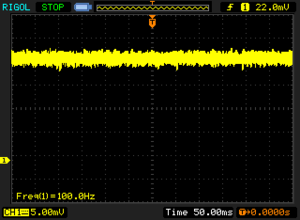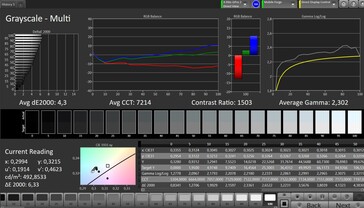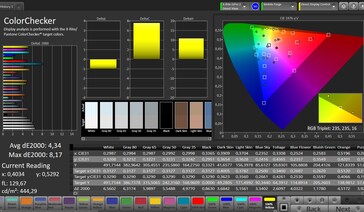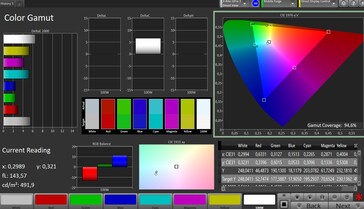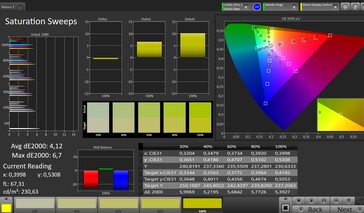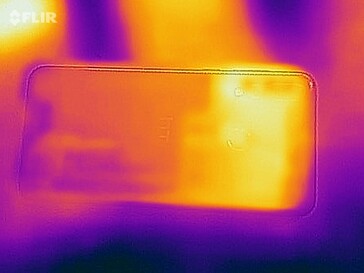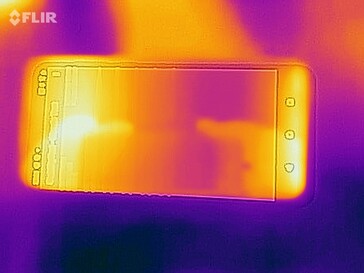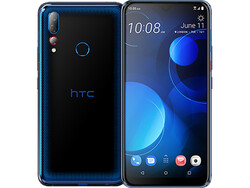HTC Desire 19+ Smartphone Review – 2,5 Cameras and Cheeky Design
Comparison units
Bewertung | Rating Version | Datum | Modell | Gewicht | Laufwerk | Groesse | Aufloesung | Preis ab |
|---|---|---|---|---|---|---|---|---|
| 77.3 % v7 (old) | v7 (old) | 10 / 2019 | HTC Desire 19+ Helio P35 MT6765, PowerVR GE8320 | 170 g | 64 GB eMMC Flash | 6.20" | 1520x720 | |
| 84.6 % v6 (old) | v6 (old) | 07 / 2019 | Honor 20 Lite Kirin 710, Mali-G51 MP4 | 164 g | 128 GB eMMC Flash | 6.21" | 2340x1080 | |
| 82.1 % v6 (old) | v6 (old) | 07 / 2019 | LG Q60 Helio P22 MT6762, PowerVR GE8320 | 172 g | 6.26" | 1520x720 | ||
| 78.1 % v7 (old) | v7 (old) | 09 / 2019 | Motorola One Action Exynos 9609, Mali-G72 MP3 | 176 g | 128 GB UFS 2.0 Flash | 6.30" | 2520x1080 |
Case, Equipment and Operation
HTC uses an exclamation mark for the housing: At least the blue model is a real eye-catcher with a reflective back and a blue dot pattern that pulls in from the edges. The Desire 19+ looks really sporty. The white version is more dignified. The case is stable, but pressure on the front comes through to the screen.
With 64 GB mass memory, the smartphone is less well equipped than Honor 20 Lite or Motorola One Action in the same price range. The Internet is pleasingly fast, but doesn't come close to the very fast WLAN of the Motorola One Action and also has to struggle with strong fluctuations in our test. LTE is available, as is an NFC chip that can be used, for example, to process payments.
The touch screen can be operated smoothly and quite smoothly. On the back there is a fingerprint sensor that unlocks the smartphone quickly and reliably. What strikes us is that the position sensor is either very hectic or delayed. This can have a negative effect on games.
| Networking | |
| iperf3 transmit AX12 | |
| Motorola One Action | |
| HTC Desire 19+ | |
| LG Q60 | |
| Honor 20 Lite | |
| iperf3 receive AX12 | |
| Motorola One Action | |
| HTC Desire 19+ | |
| LG Q60 | |
| Honor 20 Lite | |
Cameras - No real Triple-Cam
The rear triple camera consists of a 13-megapixel lens, an 8-megapixel wide-angle camera and a 5-megapixel depth-of-field supporting lens. It is therefore possible to take photos with both the normal and the wide-angle lens, so the two lenses provide more flexibility.
The image quality of the main camera is OK, in bright and dark areas many details are visible. But the sharpness of the outdoor shot leaves much to be desired in the details. Some objects are visible in the dark, the sharpness of detail is not particularly high here either, but acceptable for a cheap mid-range smartphone. Videos can be recorded in Full HD at 30 fps. The autofocus here is a bit slow and the exposure is not completely stepless in the transitions, but overall the HTC Desire 19+ offers decent video quality for the price range.
The Selfie camera is very high-resolution with 16 megapixels and takes good photos that look a bit crisisy in detail.
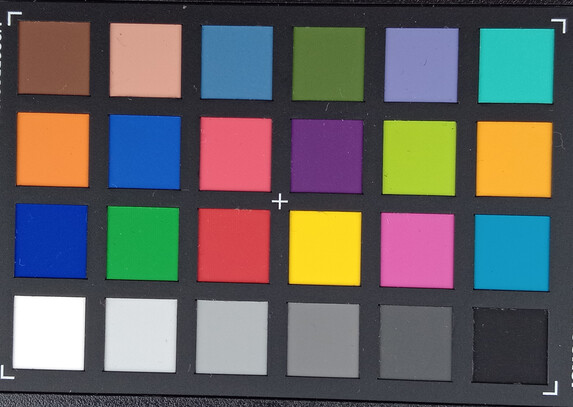
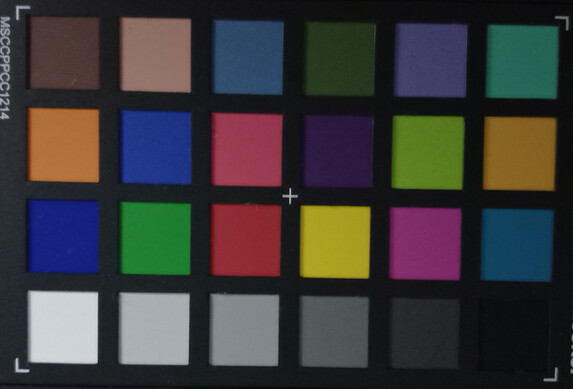
Display – No Full HD
With the display, one should be able to expect more for almost 300 euros: A 720p resolution is not enough in this price class, here Honor 20 Lite and Motorola One Action each offer a Full HD display. The brightness is good, but the illumination is somewhat uneven. On the other hand, we like the low black level of 0.33 cd/m², which makes the colors on the screen look a bit stronger. However, the display doesn't come close to an OLED display in terms of color brilliance.
A blue cast can be seen in our measurements with the spectrophotometer, but it's not that bad. The color fidelity ex works is on a quite high level. The response times of the display are quite slow, which can be noticed when scrolling fast.
| |||||||||||||||||||||||||
Brightness Distribution: 84 %
Center on Battery: 491 cd/m²
Contrast: 1488:1 (Black: 0.33 cd/m²)
ΔE ColorChecker Calman: 4.34 | ∀{0.5-29.43 Ø4.78}
ΔE Greyscale Calman: 4.3 | ∀{0.09-98 Ø5}
94.6% sRGB (Calman 2D)
Gamma: 2.302
CCT: 7214 K
| HTC Desire 19+ IPS, 1520x720, 6.2" | Honor 20 Lite IPS, 2340x1080, 6.2" | LG Q60 IPS, 1520x720, 6.3" | Motorola One Action IPS LCD, 2520x1080, 6.3" | |
|---|---|---|---|---|
| Response Times | -14% | 24% | 19% | |
| Response Time Grey 50% / Grey 80% * (ms) | 48 ? | 58 ? -21% | 38 ? 21% | 45.2 ? 6% |
| Response Time Black / White * (ms) | 30 ? | 32 ? -7% | 22 ? 27% | 20.4 ? 32% |
| PWM Frequency (Hz) | 100 | 100 ? | 9259 ? | |
| Screen | -17% | -26% | -17% | |
| Brightness middle (cd/m²) | 491 | 455 -7% | 477 -3% | 564 15% |
| Brightness (cd/m²) | 470 | 456 -3% | 437 -7% | 540 15% |
| Brightness Distribution (%) | 84 | 94 12% | 87 4% | 93 11% |
| Black Level * (cd/m²) | 0.33 | 0.58 -76% | 0.7 -112% | 0.43 -30% |
| Contrast (:1) | 1488 | 784 -47% | 681 -54% | 1312 -12% |
| Colorchecker dE 2000 * | 4.34 | 4.43 -2% | 4.84 -12% | 5.5 -27% |
| Colorchecker dE 2000 max. * | 8.17 | 6.81 17% | 8.32 -2% | 10.4 -27% |
| Greyscale dE 2000 * | 4.3 | 5.4 -26% | 5.2 -21% | 7.7 -79% |
| Gamma | 2.302 96% | 2.248 98% | 2.144 103% | 2.12 104% |
| CCT | 7214 90% | 7336 89% | 7376 88% | 8465 77% |
| Total Average (Program / Settings) | -16% /
-16% | -1% /
-16% | 1% /
-10% |
* ... smaller is better
Display Response Times
| ↔ Response Time Black to White | ||
|---|---|---|
| 30 ms ... rise ↗ and fall ↘ combined | ↗ 17 ms rise | |
| ↘ 13 ms fall | ||
| The screen shows slow response rates in our tests and will be unsatisfactory for gamers. In comparison, all tested devices range from 0.1 (minimum) to 240 (maximum) ms. » 79 % of all devices are better. This means that the measured response time is worse than the average of all tested devices (20.2 ms). | ||
| ↔ Response Time 50% Grey to 80% Grey | ||
| 48 ms ... rise ↗ and fall ↘ combined | ↗ 23 ms rise | |
| ↘ 25 ms fall | ||
| The screen shows slow response rates in our tests and will be unsatisfactory for gamers. In comparison, all tested devices range from 0.165 (minimum) to 636 (maximum) ms. » 82 % of all devices are better. This means that the measured response time is worse than the average of all tested devices (31.6 ms). | ||
Screen Flickering / PWM (Pulse-Width Modulation)
| Screen flickering / PWM detected | 100 Hz | ||
The display backlight flickers at 100 Hz (worst case, e.g., utilizing PWM) . The frequency of 100 Hz is very low, so the flickering may cause eyestrain and headaches after extended use. In comparison: 53 % of all tested devices do not use PWM to dim the display. If PWM was detected, an average of 8111 (minimum: 5 - maximum: 343500) Hz was measured. | |||
Performance, Emissions and Battery life
The Mediatek Helio P35 MT6765 is used as SoC. Our benchmarks, in which the test device is at a similar level to the Honor 20 Lite and clearly ahead of the LG Q60, show that it was chosen quite suitably. Only the graphics performance can't keep up, here Motorola One Action and Honor 20 Lite offer better values in absolute terms. However: Since the HTC Desire 19+ offers a lower-resolution screen, the graphics card doesn't have to do so much in everyday life and is usually on par in the on-screen tests.
The case warms up noticeably, but not up to the critical range.
HTC has always attached great importance to good loudspeakers, at least in its top models. The mono loudspeaker on the lower edge of the HTC Desire 19+ can be quite loud. In fact, we also like the sound quite well: not too high, quite warm, and without roaring. External audio sources that receive a clean signal can be connected via a 3.5mm connection and Bluetooth.
With its 3,850 mAh battery, the HTC Desire 19+ is well equipped and has a good 13:15 hours battery life in our WLAN test. This puts it behind the LG Q60, but still at a very high level. Two days use without an electrical outlet should be possible without any problems, those who seldom use their smartphone should manage much longer without charging. Speaking of charging: the charger delivers a maximum of 10 watts of power and thus manages to recharge the device in less than 3 hours.
| PCMark for Android | |
| Work performance score (sort by value) | |
| HTC Desire 19+ | |
| Honor 20 Lite | |
| LG Q60 | |
| Motorola One Action | |
| Average Mediatek Helio P35 MT6765 (4040 - 7753, n=8) | |
| Work 2.0 performance score (sort by value) | |
| HTC Desire 19+ | |
| Honor 20 Lite | |
| LG Q60 | |
| Motorola One Action | |
| Average Mediatek Helio P35 MT6765 (3814 - 5794, n=11) | |
| GFXBench | |
| on screen Aztec Ruins Normal Tier Onscreen (sort by value) | |
| HTC Desire 19+ | |
| Honor 20 Lite | |
| LG Q60 | |
| Motorola One Action | |
| Average Mediatek Helio P35 MT6765 (3.5 - 7.7, n=13) | |
| Average of class Smartphone (6.2 - 166, n=211, last 2 years) | |
| 1920x1080 Aztec Ruins Normal Tier Offscreen (sort by value) | |
| HTC Desire 19+ | |
| Honor 20 Lite | |
| LG Q60 | |
| Motorola One Action | |
| Average Mediatek Helio P35 MT6765 (3.8 - 4.3, n=13) | |
| Average of class Smartphone (3.4 - 367, n=211, last 2 years) | |
| on screen Aztec Ruins High Tier Onscreen (sort by value) | |
| HTC Desire 19+ | |
| Honor 20 Lite | |
| LG Q60 | |
| Motorola One Action | |
| Average Mediatek Helio P35 MT6765 (2.2 - 4.9, n=12) | |
| Average of class Smartphone (0.85 - 144, n=212, last 2 years) | |
| 2560x1440 Aztec Ruins High Tier Offscreen (sort by value) | |
| HTC Desire 19+ | |
| Honor 20 Lite | |
| LG Q60 | |
| Motorola One Action | |
| Average Mediatek Helio P35 MT6765 (1.4 - 1.6, n=12) | |
| Average of class Smartphone (1.2 - 129, n=211, last 2 years) | |
| HTC Desire 19+ | Honor 20 Lite | LG Q60 | Motorola One Action | Average 64 GB eMMC Flash | Average of class Smartphone | |
|---|---|---|---|---|---|---|
| AndroBench 3-5 | 34% | -22% | 108% | 3% | 815% | |
| Sequential Read 256KB (MB/s) | 288 | 288.1 0% | 266.2 -8% | 501 74% | 277 ? -4% | 2216 ? 669% |
| Sequential Write 256KB (MB/s) | 210.8 | 200.9 -5% | 97.9 -54% | 189.3 -10% | 178.4 ? -15% | 1837 ? 771% |
| Random Read 4KB (MB/s) | 76.5 | 38.7 -49% | 53.9 -30% | 108.4 42% | 60.7 ? -21% | 294 ? 284% |
| Random Write 4KB (MB/s) | 20.4 | 73.1 258% | 13.94 -32% | 128.5 530% | 33.8 ? 66% | 334 ? 1537% |
| Sequential Read 256KB SDCard (MB/s) | 81.8 ? | 75.7 ? -7% | 79.5 ? -3% | 78.1 ? -5% | 77.4 ? -5% | |
| Sequential Write 256KB SDCard (MB/s) | 61.8 ? | 66.9 ? 8% | 58.7 ? -5% | 70.2 ? 14% | 58.3 ? -6% |
Temperature
(±) The maximum temperature on the upper side is 41.5 °C / 107 F, compared to the average of 35.2 °C / 95 F, ranging from 21.9 to 247 °C for the class Smartphone.
(±) The bottom heats up to a maximum of 42.4 °C / 108 F, compared to the average of 34 °C / 93 F
(+) In idle usage, the average temperature for the upper side is 28 °C / 82 F, compared to the device average of 32.9 °C / 91 F.
Loudspeakers
HTC Desire 19+ audio analysis
(+) | speakers can play relatively loud (86 dB)
Bass 100 - 315 Hz
(-) | nearly no bass - on average 74.1% lower than median
(+) | bass is linear (0% delta to prev. frequency)
Mids 400 - 2000 Hz
(-) | nearly no mids - on average 74.1% lower than median
(+) | mids are linear (0% delta to prev. frequency)
Highs 2 - 16 kHz
(-) | nearly no highs - on average 74.1% lower than median
(+) | highs are linear (0% delta to prev. frequency)
Overall 100 - 16.000 Hz
(-) | overall sound is not linear (124.7% difference to median)
Compared to same class
» 94% of all tested devices in this class were better, 5% similar, 1% worse
» The best had a delta of 11%, average was 35%, worst was 134%
Compared to all devices tested
» 98% of all tested devices were better, 1% similar, 0% worse
» The best had a delta of 4%, average was 24%, worst was 134%
Honor 20 Lite audio analysis
(±) | speaker loudness is average but good (81.9 dB)
Bass 100 - 315 Hz
(-) | nearly no bass - on average 67.4% lower than median
(+) | bass is linear (0% delta to prev. frequency)
Mids 400 - 2000 Hz
(-) | nearly no mids - on average 67.4% lower than median
(+) | mids are linear (0% delta to prev. frequency)
Highs 2 - 16 kHz
(-) | nearly no highs - on average 67.4% lower than median
(+) | highs are linear (0% delta to prev. frequency)
Overall 100 - 16.000 Hz
(-) | overall sound is not linear (122.6% difference to median)
Compared to same class
» 91% of all tested devices in this class were better, 7% similar, 2% worse
» The best had a delta of 11%, average was 35%, worst was 134%
Compared to all devices tested
» 97% of all tested devices were better, 2% similar, 1% worse
» The best had a delta of 4%, average was 24%, worst was 134%
Battery life
| HTC Desire 19+ 3850 mAh | Honor 20 Lite 3400 mAh | LG Q60 3500 mAh | Motorola One Action 3500 mAh | Average of class Smartphone | |
|---|---|---|---|---|---|
| Battery Runtime | |||||
| WiFi Websurfing (h) | 13.3 | 11.4 -14% | 15.8 19% | 11.6 -13% | 19.3 ? 45% |
Pros
Cons
Verdict - Good, despite small deficits
The price of the HTC Desire 19+ has already fallen significantly on the Internet. No wonder, for 299 Euro it would be a bit too expensive in the current competitive environment, although it provides quite good arguments for its price: The large battery, for example, the bright and quite colour-true display, the good sound of the loudspeaker, and a decent system performance. The dual camera with an additional lens offers flexibility and takes decent pictures.
The WLAN is reasonably fast and the fingerprint sensor works well. The case is also available in chic blue for more extravagant buyers or in classic white for more reserved people, so there should be something for everyone.
For the currently just over 200 euros that the smartphone still costs on the Internet, it's almost a bargain: Apart from the somewhat unevenly illuminated screen, the lack of sharpness of detail of the cameras and strong fluctuations in the WLAN signal quality, we hardly have anything to complain about.
The HTC Desire 19+ has become a good smartphone, which also pleases with its extravagant exterior.
The 64 GB mass memory should also be sufficient for many people, but to be fair one has to mention that some competitors offer more.
HTC Desire 19+
- 10/26/2019 v7 (old)
Florian Schmitt




